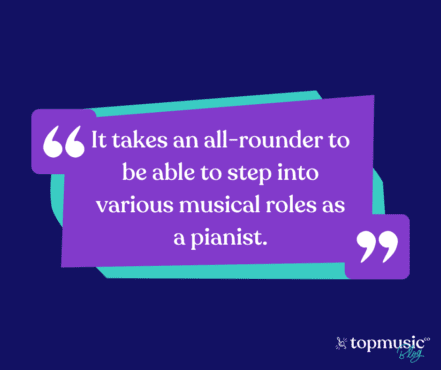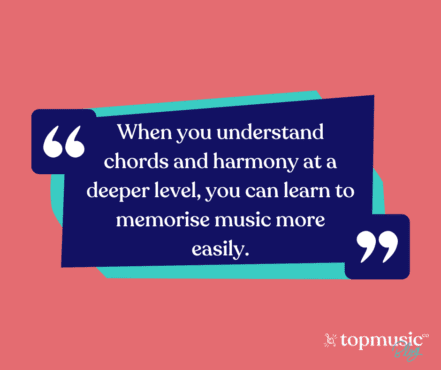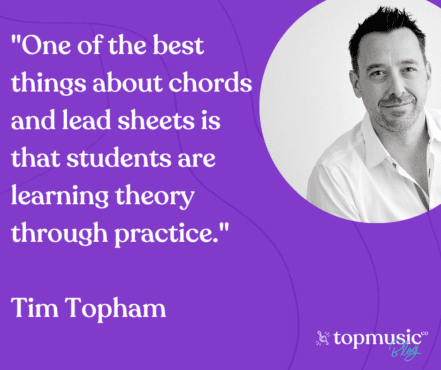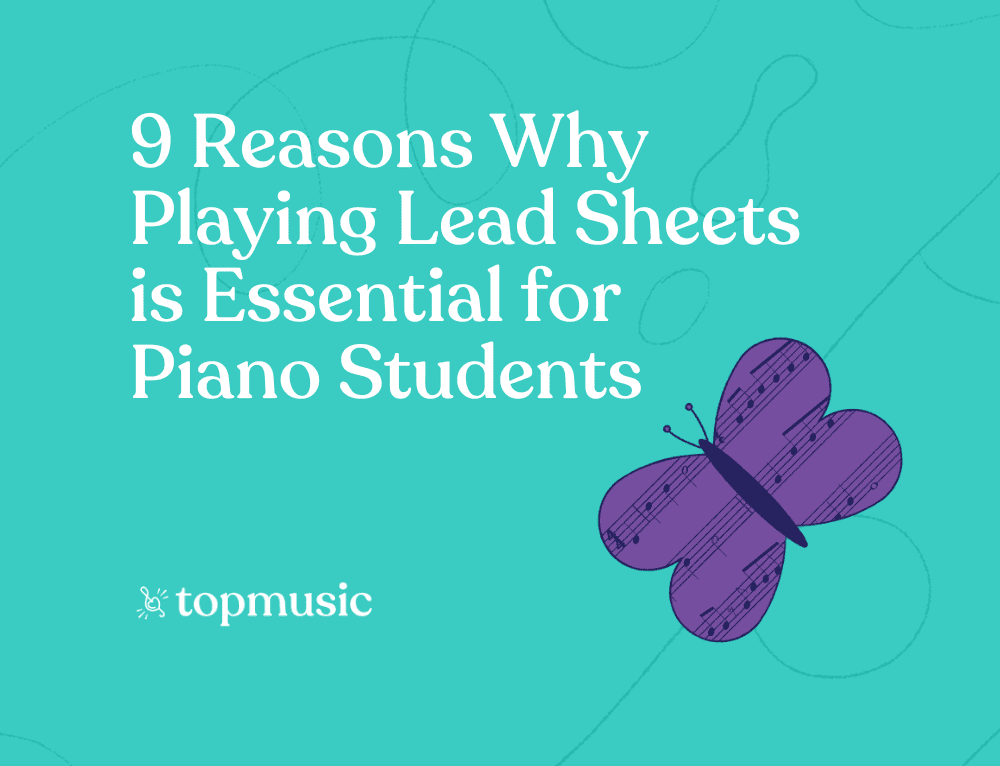Piano lead sheets are a great tool to create all-round musicians.
Playing lead sheets is an essential skill for musicians. It’s no secret that at TopMusic we are all for teaching students how to play from lead sheets! But why do we think playing from lead sheets is so important? Here are nine reasons why!
Table Of Contents:

If there’s one thing that I prioritise in lessons above everything else, it’s activities that I know will:
So what do I mean by “all-rounders”?
Of course, this was originally a cricketing term for players who were equally skilled at both batting and bowling.
But in a musical sense, it’s about setting students up for success in as many musical skills and styles of playing as possible.
So while performance of classical literature is an enriching, exciting and technically challenging skill, that will develop great readers and technically agile players, it’s not going to be very helpful when…
It takes an all-rounder to be able to step into these roles as a pianist.
Thankfully, there are a few easy ways we can help them get there.
Read more: How to inspire students with 20 creative lesson starters
I was lucky enough to be an all-rounder pianist when I was a late teenager. Looking back, I believe my ability stemmed from:

It is the last two items that really hold up all the others. If students have a strong grasp of keys, chords, expected chord progressions, modulations and common styles in the music they are playing, they will naturally be better readers. Better readers make better accompanists. Good accompanists have to be good improvisers! And so on.
The great news is that these are skills that we can give our students, if we focus on chords.
And I believe one of the best ways to explore chords is via playing lead sheets.
Firstly, we better make sure we’re all speaking the same language.
Lead Sheets have a notated melody line with chord symbols written above and may include words if it’s a song. Chord Charts simply show chord symbols with no notation. If the chord chart is referencing a pop song, it will generally include lyrics as well. In both cases, it’s up to the pianist to provide the left-hand accompaniment in the right style and groove.
Read more about the difference between a lead sheet and a chord chart by clicking here.
Lead sheets are all the more important given that all the music of today (ie. “popular music”) is provided in a lead sheet readable form. That is, pop music always has chord symbols and a melody line clearly written out. Sure, it also might have a full piano accompaniment, but it is often ridiculously hard to play. It will also feature incredibly complex rhythms.
So forget reading the music. Instead, teach students how to read lead sheets and they’ve got an all-rounder skill they will cherish (and thank you for), for life.
So let’s dig into more detail about why I believe so passionately in teaching students to read lead sheets.
Related: How one teacher transformed her whole studio through a creative approach
One of the first reasons why you’ll need to teach students about lead sheet playing is when they are asked to play in their school band or church worship music group.
All popular music for bands is written in a lead sheet style.
Rather than freaking out and rushing to teach a student how to read their band charts in between all their exam and performance repertoire, why not add this as a standard skill for all your students and make regular time for it each lesson?
Just as you teach scales, arpeggios and reading, make lead sheet playing a part of your repertoire.
You can start simply with learning how to play chords and creating progressions. You can then move onto adding chords in the LH while playing a melody in the RH.
There are heaps more reasons why you should consider this below.
We all know that students hate theory books. All the more so when the learning of theory is separated from the practice of playing an instrument.
Chords and lead sheets teach students theory through practice – the BEST way to learn. In fact, they won’t even realise most of the time.
And it’s not just about harmony. They’ll also…

When students understand that music is built on chords and harmony and they unpack that as part of their studies, they understand much more about the music they are playing.
In lead sheets, no left hand is written. Students playing lead sheets quickly learn that the foundation of piano music comes from the LH. They then have to make left-hand decisions.
They become better readers because they understand and can start to predict the harmony and movements in the LH. This is similar to how I explained sight reading above.
Most of us are realists and understand that our students will not make a living as concert pianists. But are we giving them the skills to make a living with piano in other ways?
For example, as an 18-year-old, I was able to get a job playing piano in a restaurant here in Melbourne. I was being paid $30 per hour which, back then, was a HEAP of money for a student.
Since then, I’ve made a lot of money as an accompanist for auditions, exams, choirs, and musical theatre. Most of that comes down to excellent sight reading. But my excellent sight reading isn’t just about being a good music reader. It’s because I’m a good chord player, pattern recognizer, and improviser!!
Note: the skills required for any one of these jobs are not skills generally taught in music lessons. Many of these roles require quick chord reading. This is when playing lead sheets come in handy.
Achievable piano playing jobs that require fast reading/pattern-based playing:
Chord and lead sheet work is vital, practical practice for students hoping to be able to charge money for their playing.
Let’s face it, music reading is hard.
Firstly, music is shown vertically on the page versus horizontally on the keyboard. Then there’s the issue of trying to read two hands at the same time.
Sometimes, I actually don’t know how my brain does it!
Must read: A holistic approach to reading music with Andrew Bishko
Understanding that music is created through harmony and that the simplest blocks of harmony are chords helps makes things seem easier. When you know and understand chords, you can start to see patterns in the music.
For example, when you look at a page of music, you can either see hundreds of disconnected dots that you have to try and decipher separately and put together into some kind of flow.
Or, if you understand chords, you can start to see that the music on the page is all related by harmony and is actually only made up of 6 chord positions, rather than thousands of disconnected dots.
Ask yourself this: when you look at a sheet of music, can you decipher the main harmonic movements so that you can sight-read it pretty well?
If so, great.
But what about your students?
Do they see a page of disconnected dots or a flow of connected patterns?
That’s what playing lead sheets is all about.
Lead sheet reading is much easier, especially if students can already read treble clef. Of course it’s important to learn to read both hands. But lead sheets are a great way to short-cut some of the tedium of learning to read. This then allows students to open up some of those “closed doors” of music sooner.
In fact, the more that I unpack my own ability to sight-read hard music at speed, the more I feel that I’m not actually reading two hands at the same time at all.
What I’m doing is:
My ability to ‘guess’ and improvise while I sight read is mainly a result of my understanding of chords and playing of lead sheets from a young age.
Read more: My top 10 pop songs for students to learn
I don’t know about you, but I find memorising hard (and getting harder the older I get!).
One of the scariest things about performing from memory is memory lapses. It’s one of the biggest factors contributing to performance anxiety in musicians who perform without music.
When you understand chords and harmony at a deeper level, you can learn to memorise music more easily. This is because you see things in blocks, shapes and patterns rather than just thousands of individual notes.
It’s the same for students.
If we can help them see the structure and remember that “Oh, this is where that A7 chord comes in” or “OK so this recap is in D major – don’t forget I’m in D major this time”, then the task of memorising gets easier.
Harmonic understanding will only strengthen the other memory techniques students use.
And knowing the harmony helps hugely when students have memory lapses. It allows them a skeleton or framework on which to improvise their way back to the music without stopping.
If I know that this section is in Bb major and have a memory slip, I can play some Bb arpeggiation figures that’s in the style of the music while my brain and work out where to restart.
Knowing that you have memorised the piece in multiple ways that includes harmonically and knowing that you can play yourself out of a memory lapse is goes a LONG WAY to reducing performance anxiety.
You can’t do that unless you know what you’re doing.
Much of the jazz literature that students playing in jazz bands will be expected to play is found in “Fake” or “Real” books. These were books compiled by musicians that just featured the melody and the chords (ie. lead sheets).
If students want to be able to play jazz, they need to be confident in interpreting this style.
I find that lots of my students are interested in jazz and keen to learn how to play it. While I’m no jazz pro, I do have a basic understanding. This stems from both training as a teenager from a jazz teacher and also through my own experience playing in jazz bands.
If students already understand the concept of a lead sheet, they can start to read jazz charts.
The three missing ingredients then are:
These are things that you can always add later, but it always hinges on lead sheets.
While being creative, it’s not totally “off the page”. This means teachers wanting to dip their toe in the water can try lead sheet playing out without feeling completely out of their depth.
You can try doing this with any pop music download by just ignoring the LH part.
Because the LH part isn’t notated, students are able to experiment with LH patterns and ideas and hear how different LH approaches affect the sound of the piece.
Check out my left-hand patterns blog post and free download here.
Students LOVE this kind of creative exercise and they can also try it out with other pieces.
It’s also a great excuse to get out an app like iRealPro and get students jamming along to their favourite pop songs and progressions.
You can even lead into GarageBand.

One of the best ways to help students form strong connections in the material they are learning is if they can make connections between what they are learning and things they already know and understand.
The pop music students are listening to is heavily based around chords and progressions. Teaching them about chords through lead-sheet playing is a great way of bridging the gap.
Keep in mind that “figured bass” which was used heavily in the Baroque period was really just another form of lead sheet. It told the harpsichordist or organist which notes to play about the given bass note. While modern lead sheets tend to work in the opposite direction (ie. melody note downwards), the same concepts apply.
While I’m happy that students are required to “realise” a figured bass anymore, why not continue the tradition with today’s equivalent?
If a student wants to learn a pop song before they’re able to read music at the notated level, the only option they generally have is to learn the piece from a YT tutorial.
I’ve personally got nothing against this approach. In fact, I encourage students to learn on YouTube, as long as they are still getting their other work done. But I know there are teachers who find this frustrating. They can combat the students’ desire to spend hours copying a tutorial by teaching them to play lead sheets instead.
Even elementary students can play a melody in the RH and chords in the LH and can play along to their favourite songs with a lead sheet.
Just another great reason to introduce this in your studio.
But the question is now: How do you teach this style of playing?
Well, we’ve got some great training coming up for you on exactly that topic.
If you’ve never done this before, then I understand that this style of teaching can be challenging.
That’s why I’ve been working with Forrest Kinney to create a step-by-step course for piano teachers about how to approach this style of teaching.
Follow along as Forrest demonstrates at the piano and download the workbook and musical examples.
Main tip: start early. When students are first learning to read RH in their primer books, rather than simply turn to the next piece when they’ve mastered it, get them to add either a bass note, 5ths or tried in the LH to suit the melody.
This is a great time to let students know about the most common chords that will work in a key (ie. the I, IV and V chords).
This can build into 4 Chord Composing and students get older.
Stay tuned for information on a webinar with Forrest very shortly!
For reading all the way to the end, I’d like to offer you an updated version of my “Easy Chord Progressions For Students” download. Enjoy!
